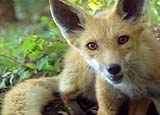| Yellowstone National Park: A journey to find the Bobcat |
| It seems as if I'm always getting wet no matter where I go. This week's adventure took me to the incredible Yellowstone National Park, a giant park that straddles the states of Montana and Wyoming. Yellowstone is filled with water and wildlife! I was having a tricky time navigating my dory down the rapids, when I spotted an American river otter. |
| The otter is a swimming mammal that belongs to the same family as badgers, skunks, and weasels. They're well adapted to river life with webbed feet, a flat tail for propulsion, and oil on their fur to make them move really fast. The otter finds its favorite food -- crayfish -- by digging in the sand. |
 |
I love coming to Yellowstone. In 1872 it became the first National Park, and federal law protects its two million acres. Once out of the boat (and away from the rapids) I spotted another animal that pretty much lives wherever it wants to -- the mink. The mink has beautiful fur and a nice bite to protect itself. And the mink will eat just about anything! |
| While I was in the water, I took a "Jacuzzi" at a spot where the cool river water meets the hot water from the underground springs. Yellowstone sits on an old, giant volcano, and the hot magma below the surface heats the springs and geysers that are found throughout Yellowstone. |
 |
I spotted a bison, which can be a dangerous animal. They don't like you getting too close, and they'll use their horns to protect themselves. Fortunately, this bison was on one side of the river and I was on the other. |
| But even more impressive, I got a good look at a Rocky Mountain elk just as it was making a loud warning noise. Male elks make this loud, horn-like sound to let other males know that they should stay away. They use their antlers to protect their harems. I also spotted a conifer with the bark rubbed off. This is noteworthy because elk rub their antlers against trees to scrape off the antler fur that grows on them each spring. |
 |
 |
But my quest here is for the elusive bobcat, and that means climbing. I pass two young gray wolves playing. Wolves were once almost extinct in Yellowstone, but they were recently reintroduced to the park. I spot the "Mama" wolf, who has rare black fur. The pups will live in a den, and when they're older, they'll join a pack in which they will learn to cooperate -- vital for a wolf. |
| On the way up I also see a red fox. Though it looks catlike, it's not related to cats at all. The red fox is an excellent mouser and, unlike the wolf, hunts alone. But when it's digging for prey, the fox has to be careful not to get eaten by a coyote. Coyotes prey on foxes! |
 |
 |
You know I like to find food in the wild, and a pinecone provides a tasty treat: pine nuts. They're rich in fat and good for my metabolism -- and they taste good!
I finally find this week's elusive Feature Creature, the bobcat, on a cliff. The bobcat gets its name from the way the tail is bobbed. It stops me dead in my tracks, telling me not to come any closer with its ominous hissing.
|
| When I back off, I see a nice surprise -- a frisky five-month-old bobcat which is a lot more friendly than Dad. Though it's small, the young bobcat has the same pointy ears as the full-grown version. And as the little bobcat climbs over to its father, it is time for me to climb on to my next adventure!
|





